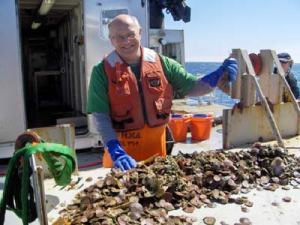NOAA Teacher at Sea
Duane Sanders
Onboard Research Vessel Hugh R. Sharp
June 8-19, 2009
Mission: Sea Scallop Survey
Geographical Area: New England Coast
Date: June 10, 2009
Weather Data from the Bridge
Wind: Speed 19.4 KTS, Direction 86.8 degrees
Barometer: 1013 millibars
Air temperature: 14.2 0C
Seas: 2-3 feet

Science and Technology Log
The primary mission of this cruise is to complete the second leg of a three-leg survey of scallop populations along the New England Coast. Other information about the scallop ecosystem is also collected. Scientists evaluate the status of the scallop fishery use data gathered from the survey. Decisions about which areas to allow commercial scalloping and which areas to close to commercial use are based on these surveys. These science-based management decisions help to promote long-term stability of the scallop industry.

After two complete watches, I think I understand the procedure. Stations to be sampled are determined by a stratified random sampling procedure. Computers, following certain parameters set by NOAA staff, determine which area is to be sampled. It is important to be consistent so that each station from each of the three legs of the cruise can be reliably compared other data from this survey as well as from other years. Once the captain puts the ship on station, an eight-foot wide dredge is lowered to the bottom and dragged for 15 minutes. The captain keeps the ships speed to a constant 3.8 knots. When the dredge is hauled in, its contents are dumped on a large steel sorting table that is bolted onto the to deck. The science team on watch sorts through the contents of the catch and separates all scallops into one basket, all fish into a different bucket and all the rest of the haul into another basket.
We then determine the total weight of the scallops and measure the length of each one. Thankfully we use a computerized system for determining the lengths which automatically record them. All of the fish are sorted by species, and then weighed by species. The length of each fish is recorded using the same system as for the scallops. The total volume of the remaining haul is estimated with each basket being equivalent to 46 liters. The general contents of the basket are characterized by types of shells found, types of substrate material and other organisms present.
Personal Log

I have been assigned to the night watch. This means we work from midnight to noon. Although I am doing better today, it has been difficult to adjust to sleeping during the day. I am sure that I will continue to adapt. As long as Paul, our cook, keeps preparing his delicious meals I will survive quite nicely!
I have really enjoyed seeing the variety of organisms that come up in the dredge. My favorites are the invertebrates. Some examples include different species of starfish, other mollusks beside scallops, and sea mice. A sea mouse is actually a marine worm in the group known as polychaetes. These strange looking creatures grow long, thin scales that looks like fur. Their bodies have the general shape of a mouse with no tail. There are also many fish species, which I am learning about, but they do not interest me as much as the other organisms.

